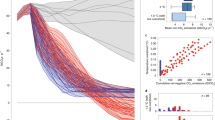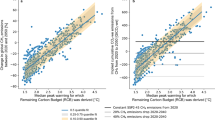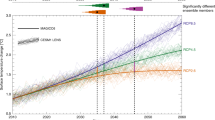Abstract
Recent downward revisions in the climate response to rising CO2 levels, and opportunities for reducing non-CO2 climate warming, have both been cited as evidence that the case for reducing CO2 emissions is less urgent than previously thought. Evaluating the impact of delay is complicated by the fact that CO2 emissions accumulate over time, so what happens after they peak is as relevant for long-term warming as the size and timing of the peak itself. Previous discussions have focused on how the rate of reduction required to meet any given temperature target rises asymptotically the later the emissions peak. Here we focus on a complementary question: how fast is peak CO2-induced warming increasing while mitigation is delayed, assuming no increase in rates of reduction after the emissions peak? We show that this peak-committed warming is increasing at the same rate as cumulative CO2 emissions, about 2% per year, much faster than observed warming, independent of the climate response.
This is a preview of subscription content, access via your institution
Access options
Subscribe to this journal
Receive 12 print issues and online access
$209.00 per year
only $17.42 per issue
Buy this article
- Purchase on Springer Link
- Instant access to full article PDF
Prices may be subject to local taxes which are calculated during checkout

Similar content being viewed by others
References
Aldrin, M. et al. Bayesian estimation of climate sensitivity based on a simple climate model fitted to observations of hemispheric temperatures and global ocean heat content. Environmetrics 23, 253–271 (2012).
Lewis, N. An objective bayesian improved approach for applying optimal fingerprint techniques to estimate climate sensitivity. J. Clim. 26, 7414–7429 (2013).
Gillett, N. P. et al. Constraining the ratio of global warming to cumulative CO2 emissions using CMIP5 simulations. J. Clim. 26, 6844–6858 (2013).
Otto, A. et al. Energy budget constraints on climate response. Nature Geosci. 6, 415–416 (2013).
Ridley, M. Earth to Met Office: check your climate facts. The Times (20 May 2013, updated 24 May 2013); available via http://www.rationaloptimist.com/blog/the-implications-of-lower-climate-sensitivity.aspx
Shindell, D. et al. Simultaneously mitigating near-term climate change and improving human health and food security. Science 335, 183–189 (2012).
Bond, T. C et al. Bounding the role of black carbon in the climate system: A scientific assessment. J. Geophys. Res. 118, 5380–5552 (2013).
Global warming: The new black. The Economist (19 January 2013).
Stocker, T. The closing door of climate targets. Science 339, 280–282 (2012).
Huntingford, C. et al. The link between a global 2 °C warming threshold and emissions in years 2020, 2050 and beyond. Environ. Res. Lett. 7, 14039 (2012).
Rogelj, J. et al. Probabilistic cost estimates for climate change mitigation. Nature 493, 79–83 (2013).
Luderer, G. et al. Economic mitigation challenges: How further delay closes the door for achieving climate targets. Environ. Res. Lett. 8, 034033 (2013).
Held, I. M. et al. Probing the fast and slow components of global warming by returning abruptly to preindustrial forcing. J. Clim. 23, 2418–2427 (2010).
Gregory, J. M. & Forster, P. M. Transient climate response estimated from radiative forcing and observed temperature change. J. Geophys. Res. Atmos. 113, D23105 (2008).
Zickfeld, K. et al. Setting cumulative emissions targets to reduce the risk of dangerous climate change. Proc. Natl Acad. Sci. USA 106, 16129–16134 (2009).
Matthews, H. D. et al. The proportionality of global warming to cumulative carbon emissions. Nature 458, 829–832 (2009).
Smith, S. M. et al. Equivalence of greenhouse-gas emissions for peak warming. Nature Clim. Change 2, 535–538 (2012).
Allen, M. R. et al. Warming caused by cumulative carbon emissions towards the trillionth tonne. Nature 458, 1163–1166 (2009).
Meinshausen, M. et al. Greenhouse gas emission targets for limiting global warming to 2 °C. Nature 458, 1158–1162 (2009).
Stocker, T. F. et al. (eds) Climate Change 2013: The Physical Science Basis. Summary for Policymakers (IPCC, Cambridge Univ. Press, 2013).
Stott, P. A., Good, P., Jones, G., Gillett, N. P & Hawkins, E. The upper end of climate model temperature projections is inconsistent with past warming. Environ. Res. Lett. 8, 014024 (2013).
Andres, R. J. et al. A synthesis of carbon dioxide emissions from fossil-fuel combustion. Biogeosciences 9, 1845 (2012).
Victor, D. G., Kennel, C. F. & Ramanathan, V. The climate threat we can beat. Foreign Aff. 91, 112–114 (2012).
Bowerman, N. H. A. et al. The role of short-lived climate pollutants in meeting temperature goals. Nature Clim. Change 3, 1021–1024 10.1038/nclimate2034 (2013).
Steinacher, M., Joos, F. & Stocker, T. F. Allowable carbon emissions lowered by multiple climate targets. Nature 499, 197–201 (2013).
Acknowledgements
M.R.A. acknowledges support from the UK Department of Energy and Climate Change under contract TRN 317/11/2011 and from the Oxford Martin School.
Author information
Authors and Affiliations
Corresponding author
Ethics declarations
Competing interests
The authors declare no competing financial interests.
Rights and permissions
About this article
Cite this article
Allen, M., Stocker, T. Impact of delay in reducing carbon dioxide emissions. Nature Clim Change 4, 23–26 (2014). https://doi.org/10.1038/nclimate2077
Received:
Accepted:
Published:
Issue Date:
DOI: https://doi.org/10.1038/nclimate2077
This article is cited by
-
Climate intervention on a high-emissions pathway could delay but not prevent West Antarctic Ice Sheet demise
Nature Climate Change (2023)
-
Review of carbon capture and storage technologies in selected industries: potentials and challenges
Reviews in Environmental Science and Bio/Technology (2023)
-
The impact of brick kilns on environment and society: a bibliometric and thematic review
Environmental Science and Pollution Research (2023)
-
The meaning of net zero and how to get it right
Nature Climate Change (2022)
-
Functionalized COFs with Quaternary Phosphonium Salt for Versatilely Catalyzing Chemical Transformations of CO2
Chemical Research in Chinese Universities (2022)



